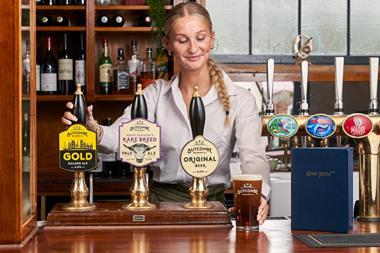US diners are seeing fish as a healthy alternative to meat when it comes to main meals. Darren Tristano, of Technomic, reveals the differences between how young and older audiences view this shift
In the US, restaurant-goers are most likely to choose chicken, beef and pork as a
centre-of-the-plate option when they dine out. Yet fish and shellfish remain enduring fixtures on restaurant menus. Today, most US consumers (69%) eat seafood as a main course or as a central main-course ingredient at least once every 90 days.
In addition, half of consumers who have increased their purchases of seafood during the past two years say they are eating more seafood in lieu of meat. This shift is leading restaurant operators to evaluate their mix of seafood and meat dishes, and work with their suppliers to deliver enough seafood options to meet customer demand.
Technomic’s recently published The Center of the Plate: Seafood & Vegetarian Consumer Trend Report for 2015 examined consumer behaviour and attitudes about seafood and the following explores some of the key trends uncovered by the research. Top seafood trends revolve around the demand for greater menu variety, growth of the fast-casual sector, and the increasing importance of health and sustainability.
Variety is a must
A slight majority of seafood consumers would like to see restaurants offer a greater variety of seafood dishes in general. Just under half say the same for seafood mains with new or unique flavours, and slightly fewer indicate a demand for ethnic seafood dishes.
Younger consumers are more likely than older consumers to demand greater variety of seafood offerings. This could be because younger consumers are generally more reliant on foodservice than older consumers and like to vary their purchases. Younger consumers also enjoy trying new food. When analysing the data by ethnicity, the data showed that Hispanics are more likely than any other ethnicity to say that they’d like restaurants to offer a greater variety of seafood options.
While US consumers indicate a burgeoning interest in a wider seafood variety, they also voice clear preferences for certain popular types of fish and shellfish. Tilapia, cod, tuna and catfish are among the favourite fish varieties according to consumers, likely because they are among the most widely offered at leading chains.
Younger consumers show greater preference for salmon, tilapia and tuna than older consumers, whereas those aged 35 and older report greater interest in flounder, halibut and trout. In addition, more men than women prefer cod, halibut (39% of men v 33% of women) and trout (38% of men v 32% of women).
In terms of shellfish, far more consumers say they would order shrimp at restaurants or other foodservice locations than any other variety of shellfish measured. Beyond lobster and crab, scallops and clams round out the top five options. While younger consumers are more likely to order calamari, older consumers are more likely to indicate a preference for scallops. Among all US regions, those from the north-east indicate preference for scallops, clams, calamari and mussels.
One of the more interesting menu trends that higher-end US restaurant operators are employing to emphasise variety calls for the promotion of so-called ‘trash’ fish. The current chef-driven movement to menu more ‘trash’ fish – or lesser-known fish species that many anglers consider to be a nuisance – not only highlights kitchen creativity, but takes pressures off overfished species.
Non-profit chef organisation Chefs Collaborative holds ‘trash fish dinners’ across the country, bringing attention to undervalued and underutilised fish species. ‘Trash’ fish species to look out for on today’s US menus (especially in the fine-dining arena) include whiting, mackerel, trigger fish, drum, scorpion fish, Asian carp, rainbow smelt and even salmon heads.
Fast-casual is emerging
Technomic research shows that fast-casual seafood concepts are poised for further expansion, particularly in coastal areas and urban centres in the US. Known for high-quality preparations and affordable price points in comparison to full-service restaurants, the fast-casual sector – a high-growth segment of the overall restaurant industry – will be the breeding ground for growth chains specialising in seafood.
Sustainable sourcing will be a primary facet of the larger concept positioning strategy for these new chains. Additionally, they will be marketed toward an affluent and/or a younger consumer audience. Customisation platforms, build-your-own seafood dishes and trendy foods (such as fish, lobster or shrimp tacos) will be strongly highlighted on fast-casual menus.
Newer chains, such as Da Lobsta in Chicago; My Ceviche in Miami Beach, Florida; and Slapfish in California; present consumers with contemporary decor elements and signature items, such as build-your-own ceviche bowls, lobster rolls, fresh fish plates, tacos and speciality sandwiches.
While the opportunity exists to introduce attention-grabbing, fast-casual concepts for seafood, upscale limited-service operators must be mindful of price points to successfully leverage this trend. For example, in 2009, Panera Bread first tested a $16.99 lobster roll in 50 New England-based locations; as of last year, the price dropped to $14.99 because the item likely struggled to find a foothold at the higher price. Fast-casuals must find the ‘sweet spot’ when pricing seafood items, so higher-priced offerings don’t underperform and lower-priced items don’t lead consumers to question quality levels.
Health and sustainability
Consumption of seafood options is largely driven by health because many consumers consider fish and other sea-based fare to be healthier than beef, pork or poultry. Therefore, restaurant operators and suppliers are discovering that seafood offerings can help them meet increasing demand for healthy foodservice options. In turn, this can help broaden appeal and drive incremental traffic and sales.
But how are US restaurant consumers identifying health for seafood? The newly evolving definition appears to prominently include seafood that is certified, fresh and sustainable. Overall, more than half of consumers surveyed (52%) called certification of seafood an important factor when they dine out.
Additionally, almost half (46%) cited sustainability as an important attribute for the seafood they eat in restaurants. This preference is indeed one that is trending forward, as consumers increasingly expect restaurants to be transparent in their sustainability and sourcing practices.
Consumers are also in search of wild-caught seafood and rate it as being important. More than a third (37%) of consumers seek out seafood offerings that are sourced by environmentally sound methods from non-depleted US waters.
The prevailing finding of our research on consumer preferences for health and sustainability reveals that consumers under the age of 35 are far more likely than older diners to place high importance on these menu claims, particularly for sustainable and certified seafood. This suggests that consumer attention will be increasingly focused on these attributes, and in res-ponse, US restaurant operators and sup-pliers will highlight these qualities more frequently over time.
A number of top restaurant chains are already at the forefront of this trend. McDonald’s began using sustainable fish in 2005. In 2013, the quick-service leader began using a Marine Stewardship Council seal on its products to denote sustainability and traceability of its fish.
Fast-casual chain Roti Mediterranean Grill offers sustainable, naturally raised salmon. Served within one week of being harvested, the salmon is sourced from True North Salmon Company, which practices site rotation in the ocean to allow for organic renewal of sourcing sites. And quick-serve chain Long John Silver’s partners with the Global Aquaculture Alliance to establish best practices and certification for its sustainable seafood procurement policies.
The keepnet
Consumers truly want restaurants to offer seafood that they can’t easily replicate at home. Providing a greater variety of seafood dishes may help restaurants drive traffic and sales; offering more unique varieties of seafood that are less expensive may help to boost sales of seafood among price-conscious consumers.
Health is the leading reason why consumers who eat seafood items choose to do so. As consumers demand more healthy options from foodservice, operators and suppliers may want to offer seafood, especially certified and fresh/never frozen preparations, to meet demand and boost health perceptions.
Origin labels for seafood are increasingly important as concerns around sustainability rise. Restaurant operators and suppliers can use these consumer sentiments to build a selling story that explains where their seafood came from to increase awareness and help drive sales.
Nevertheless, research shows descriptors relating to quality and freshness are more likely to spur purchases and increase price thresholds for seafood than claims related to sustainability. Operators may want to highlight both the quality and sustainability attributes of their seafood offerings on their menu and in their marketing message.
Darren Tristano is senior managing director of Technomic Inc, a Chicago-based foodservice consultancy and research firm. Since 1993, he has led the development of Technomic’s Information Services division and directed multiple aspects of the firm’s operations. For more information, visit www.technomic.com.



































